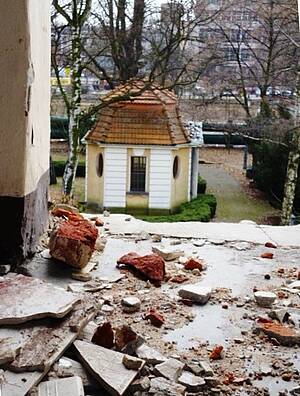Nation and class in the city's memory. On change in the culture of remembrance in Łódź since 1945
 |
The systematic development of Łódź into a Central European hub of textile production was already underway in 1820. The ensuing economic growth and rapidly increasing population of the city gave rise to a mythology that presented it as the "Manchester of the East".
In 1899, Władysław Reymont's "Ziemia Obiecana" ("The Promised Land") provide Łódź with its own emblematic novel, a book which was to saddle the city with a lasting negative reputation. At the same time the beginnings of industrial Łódź were characterized by a diversification of the city's ethnic and social make-up, as Polish, German, Jewish and Russian entrepreneurs, workers and administrative classes intermingled. The Second World War, which brought German occupation and the creation of the Litzmannstadt ghetto, put an end to this diversity. Expulsions, forced resettlements and the deportation and murder of the city's Jews transformed the population mix permanently.
Interpretations of local history and the culture of remembrance in the once multi-ethnic industrial city of Łódź after 1945 were guided by overarching ideas of nation and class, which always interacted in a specific, yet ever-changing, relationship to one another. During the time of the People's Republic, Łódź's pre-war multi-ethnic past was either ignored or presented hand in hand with Marxist ideas on class tensions, underlining its relevance in the creation of national antagonisms. 1989 brought with it both a renewed interest in the multicultural heritage of the city and a new appreciation of the "civic values of the entrepreneur". Recent years have seen the development of a more positive local identity, involving a harking back to the (perhaps rose-tinted) image of a tolerant, multicultural, capitalist society at the turn of 19th to 20th Century, a vision that has since become integrated into Łódź's image of itself and into the city's marketing.
This dissertation attempts to analyze the changing view of nationality and class since 1945 using a number of sample realms of memory in the mnemotopos of Łódź. On the one hand, mnemotopoi through which changes in remembrance patterns come into focus – national uniformity vs. ethnic diversity; class struggle and revolution vs. tolerance and community; social pauperization vs. private charity; "the masses" vs. the individual; the dignity of the worker vs. entrepreneurship – on the other, realms of memory can be seen as intersections between local, national, and global discourses and interests in relation to remembrance.
For this reason, both public and private sector bearers of memory both within and outside the city are also looked at in the study. Beyond the local context, therefore, the project also aims to provide insights into processes of inter-ethnic and institutional transmission of collective memory.
Ulrike Lang

Mitglied im

